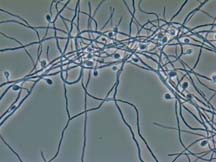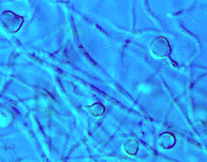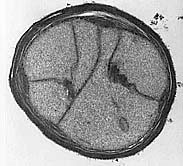
Frankia CcI3 /w vesicles (Phase contrast, rollover with DAPI/Sytox Green) (Benson, Bourret, Harriot-Sims)

Frankia CpI1 /w vesicles (Nomarski optics) (D. Benson)

Frankia ChI1 hyphae grown on NH4+ -containing medium (D. Benson)
Physiology
The availability (January, 2005) of three Frankia genomes provided a wealth of information about Frankia physiology. Some of the observations from the genome sequencing projects can be found here. Links to metabolic pathways are found on the individual genome pages.
Carbon Sources
Frankia Growth Media |
||||
| CB-CcI3 | DPM | FDM | BAP | FTW |
All Frankia strains are obligate chemoorganotrophic aerobes. The list of compounds on which they can grow is usually quite short. Strains from Cluster 1 tend to grow mainly on short chain fatty acids (propionate, acetate) and some TCA cycle intermediates (succinate, malate) and pyruvate. More complex C-sources such as carbohydrates, cellulose, pectin, proteins, amino acids, and so on are not used.
Strains from Cluster 3 are somewhat broader in their selection of C-sources. They grow on carbohydrates like glucose or fructose as well as acetate, propionate, pyruvate and TCA cycle intermediates. Not all strains grow on all compounds. The only universal substrate seems to be propionate and perhaps acetate.
Nitrogen metabolism
Ammonia is the best N-source for growing frankiae. Amino acids that are catabolized as ammonia are also good growth substrates (his, gln).
Vesicles and N2-fixation are induced in N-free medium, or in medium with amino acids catabolized as glutamate (asp, ala, pro). N-regulation in frankiae occurs via the glutamine synthetase cascade where the a-kg:gln ratio controls the Ntr reponse leading to the induction of vesicles and N-fixation. Amino acids catabolized as glutamate do not create ammonia, leading to a reduction of glutamine pools and a consequent activation of nitrogen fixation (Zhang, 1992).
Ammonia assimilation occurs via the glutamine synthetase-glutamate synthase (GS-GOGAT) cycle. Frankiae have two GSs. GSI (encoded by glnA) is constitutive and is regulated by an adenylylation cascade. GSII (encoded by glnII) is induced during N-starvation and is not regulated by adenylylation (Edmands et al., 1987). The enzymes for GOGAT are apparently missing in vesicles, suggesting that glutamine or ammonia is released to vegetative cells for growth (Schultz & Benson, 1990).
Vesicles are commonly made in response to nitrogen deprivation. They contain nitrogenase and ancillary enzymes and thus are most likely anaerobic inside. Frankiae can grow on nitrogen gas, albeit more slowly than on ammonia. (More on vesicles)

